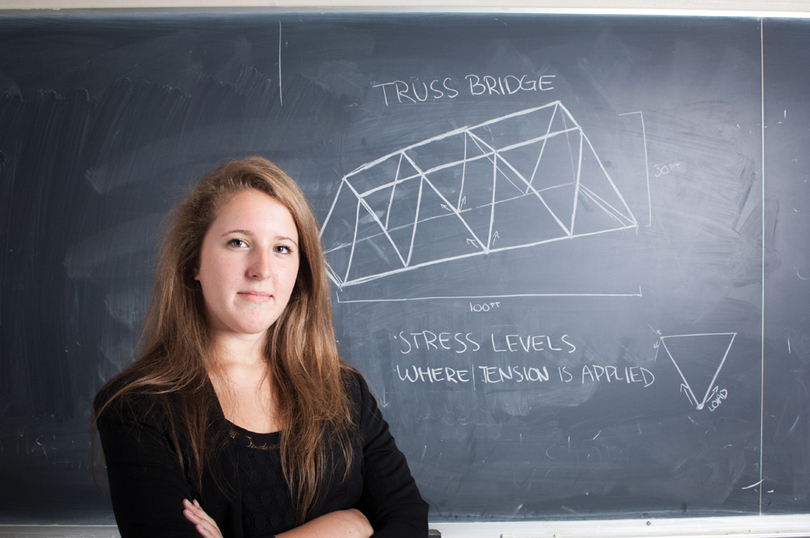Gearing up: Female enrollment increases in engineering school
CORRECTION: In a previous version of this article, the female-to-male student ratio at other engineering schools was misstated. At other schools, males outnumber females 20 to 1. The Daily Orange regrets this error.
When Michelle Dube was a little girl, she preferred Lincoln Logs to Barbies. For Callie Sher, she liked to spend her time fixing motorcycles and cars as a kid.
Now, both are students at Syracuse University’s L.C. Smith College of Engineering and Computer Science, and credit their interest in engineering to the environments in which they grew up.
“When I was in high school, nobody ever encouraged me to continue with math and science,” said Kathleen Joyce, assistant dean for student recruitment at L.C. Smith. “Since then, I think our culture has changed a lot, we’re not as slotted into predetermined categories.”
In the past eight years, female enrollment at L.C. Smith has increased by five percent to a total of 28 percent. To some, this may seem like a small improvement, but for many female engineers at SU it is an inspiring statistic that stems from the college’s efforts to grow its female community.
Though the gap between female and male students is starting to close, there is still much to be done.
“This is a persistent, systemic issue where we have seen a lack of encouragement toward women to pursue math and science opportunities in college,” Joyce said. “I think it’s important that all students are educated about what these fields are.”
Since beginning at SU twenty years ago, Joyce has seen a marked change in the level of encouragement for females entering the science and engineering fields.
In 2008, L.C. Smith appointed Laura Steinberg as its first female dean. Steinberg still serves as dean today. In 2011, 90 women graduated from the school and in 2012 that number increased to 106.
Education, Joyce believes, lays the groundwork for interest in any field, but must be stressed as early as fourth grade to really capture a student’s attention. In engineering, students sometimes fail to visualize how they can apply it in everyday life, so educating them about its “crucial place in our world” is a key part of sustaining their interest, she said.
Others cannot look past the complexity in engineering programs, believing the four years it takes to receive a degree is too rigorous, said Alexis Lopriore, a junior bioengineering major.
“It definitely is difficult, but if you want it bad enough, then you just have to push through it for four years,” Lopriore said. “We know why we are there and we stick to that.”
Caitlin Houghton, a junior biomedical engineering major, said people often insinuate she’ll find a job more easily than her male peers because she is a female in a male-dominated field.
She said even though the program is challenging, there are a good amount of females in most of her major’s classes.
Dube, a sophomore civil engineering major, said that, compared to the other engineering schools she visited, L.C. Smith had a surprisingly large amount of females in the engineering program. Other schools, she said, held a male to female ratio of 20:1 for engineering students.
“Compared to other schools like Newhouse, Whitman and VPA, having females be 28 percent of the student body seems pretty low,” Dube said. “But when you’re in the field and you’ve been looking at different schools, it’s actually a lot.”
Dube said she wasn’t expecting to be surrounded by many females when coming to L.C. Smith. When in a smaller class of nearly 20 students, she said she was pleasantly surprised to find there were eight female students.
Outside of the engineering community at L.C. Smith, Dube said, most female engineers discover their passion through a natural inclination toward math and science, as well as their family backgrounds. Her father is an engineer, she said, so he geared her toward science-based activities in her childhood.
“Growing up, I don’t think girls are as open to the idea of math and science,” Dube said. “The toys that we’re brought up on, such as Legos being for boys and Barbies being for girls, is somewhat at fault for this.”
Sher, a junior mechanical engineering major, said her family had a lot to do with sparking her interest in engineering. Like Dube, Sher’s father is also an engineer, so she would spend her free time working on cars and motorcycles with him. From this, Sher became interested in working with machinery and decided to pursue a degree in mechanical engineering.
Though she loves her program at L.C. Smith, Sher said she still feels like a minority within the student body.
“I sit next to most of the girls and sometimes there are 10 girls in a 100 person class,” Sher said. “I think people definitely notice the deficit, but I also think we might be moving past it a little bit.”
Even though she feels like a minority, Sher said she also appreciates some of the qualities that come along with it, such as the feelings of accomplishment and the ability to stand out more easily. She said groups like the Society of Women Engineers at L.C. Smith also help students realize the positives to their situation.
Along with SWE, L.C. Smith also has a group called Women in Science and Engineering, which develops relationships between female students and faculty members in the sciences and engineering fields.
These programs, which help create a “welcoming sense of community” for women at L.C. Smith, were further aided by a five-year $3.4 million National Science Foundation Advance grant, which was awarded in 2010 to strengthen the presence of female faculty members in science and engineering, said Laura Steinberg, dean of L.C. Smith.
Part of the reason why this grant is so important, Steinberg said, is because there is a lack of strong female role models for women in the engineering field. When students lack role models and their parents aren’t engineers, she said, engineering becomes an unknown, undiscovered field.
In a recent survey released by the school, Steinberg said the most common word students used to characterize L.C. Smith was “community.” The idea of a welcoming community is what attracts more undergraduate students to L.C. Smith, and this remains especially true for females entering the field of engineering, she said.
“We show L.C. Smith to be attractive in the way that we present ourselves – we say we’re welcoming to women and we know there will be a lot of women in our courses,” Steinberg said. “This supports the idea that L.C. Smith is a team-oriented place, where females work together instead of working against each other.”
For the future, Steinberg said the United States needs to change how it communicates the field of engineering to female students. Describing not only the principles learned in engineering, but the problems that engineers solve as well, is an important distinction, she said.
“We know that it’s not that women aren’t good at it because women have just as good of an aptitude in science,” Steinberg said. “We just haven’t explained the pleasures and the joys that we get from engineering.”
Published on August 28, 2013 at 2:35 am
Contact Annie: apalme05@syr.edu










